Pickleball’s skyrocketing popularity isn’t just because it’s fun; it’s also incredibly accessible. But what do you do when you’re itching to improve your game and there’s no one around to play with? That’s where solo practice comes in. It’s the perfect opportunity to hone your skills, and with the right drills, you can make significant strides on your own.
Solo practice doesn’t have to be a monotonous affair. In fact, it can be just as engaging and productive as playing with a partner. From working on your serve to improving your footwork, there are plenty of effective drills designed to boost your pickleball prowess. Whether you’re a beginner looking to master the basics or an advanced player aiming to sharpen your strategies, solo drills can be tailored to suit your needs and keep you at the top of your game.
Benefits of Solo Practice in Pickleball
Solo practice in pickleball offers a unique set of advantages that can help players enhance their game outside the dynamics of a regular match. By focusing on individual skills and techniques, players can identify and work on their weaknesses, turning them into strengths. This dedicated practice time allows for concentrated effort on particular aspects of the game, which might be overlooked in a standard play scenario.
One of the primary benefits is improved precision. Without the unpredictability of an opponent’s shots, players can repeatedly target specific zones of the court, honing their accuracy with serves, dinks, and drives. This repetition reinforces muscle memory, making precise shot placement more automatic in competitive play. Additionally, solo practice is the perfect opportunity to master the serve. Since serves can significantly influence the flow of the game, players can use this time to experiment with different serving techniques and speeds, finding what works best for their style of play.
Another advantage is enhanced footwork and mobility. Pickleball requires quick, agile movements to cover the court effectively. Through drills focusing on lateral movement, quick steps, and reaching, players can improve their ability to get to the ball more efficiently. This kind of practice promotes endurance and agility, which are vital for prolonged rallies and maintaining energy levels during matches.
Furthermore, solo practice offers a level of flexibility and convenience that playing with a partner or group cannot match. Players can set their own schedule, pace, and focus areas without needing to coordinate with others. This accessibility is especially beneficial for those with busy lifestyles or limited access to willing or available playing partners.
One often overlooked aspect of solo practice is the opportunity for mental conditioning. The solitary nature of the practice allows players to develop concentration, focus, and resilience. They learn to maintain a positive mindset, manage frustration, and set personal goals, which are all critical psychological components of competitive play.
Lastly, solo drills can be tailored to both beginner and advanced players, making them an inclusive way for anyone to improve their game. Beginners can focus on the basics, such as consistent serving and simple forehand and backhand shots, while advanced players can challenge themselves with more complex drills designed to refine their strategy and shot variety.
Importance of Effective Drills
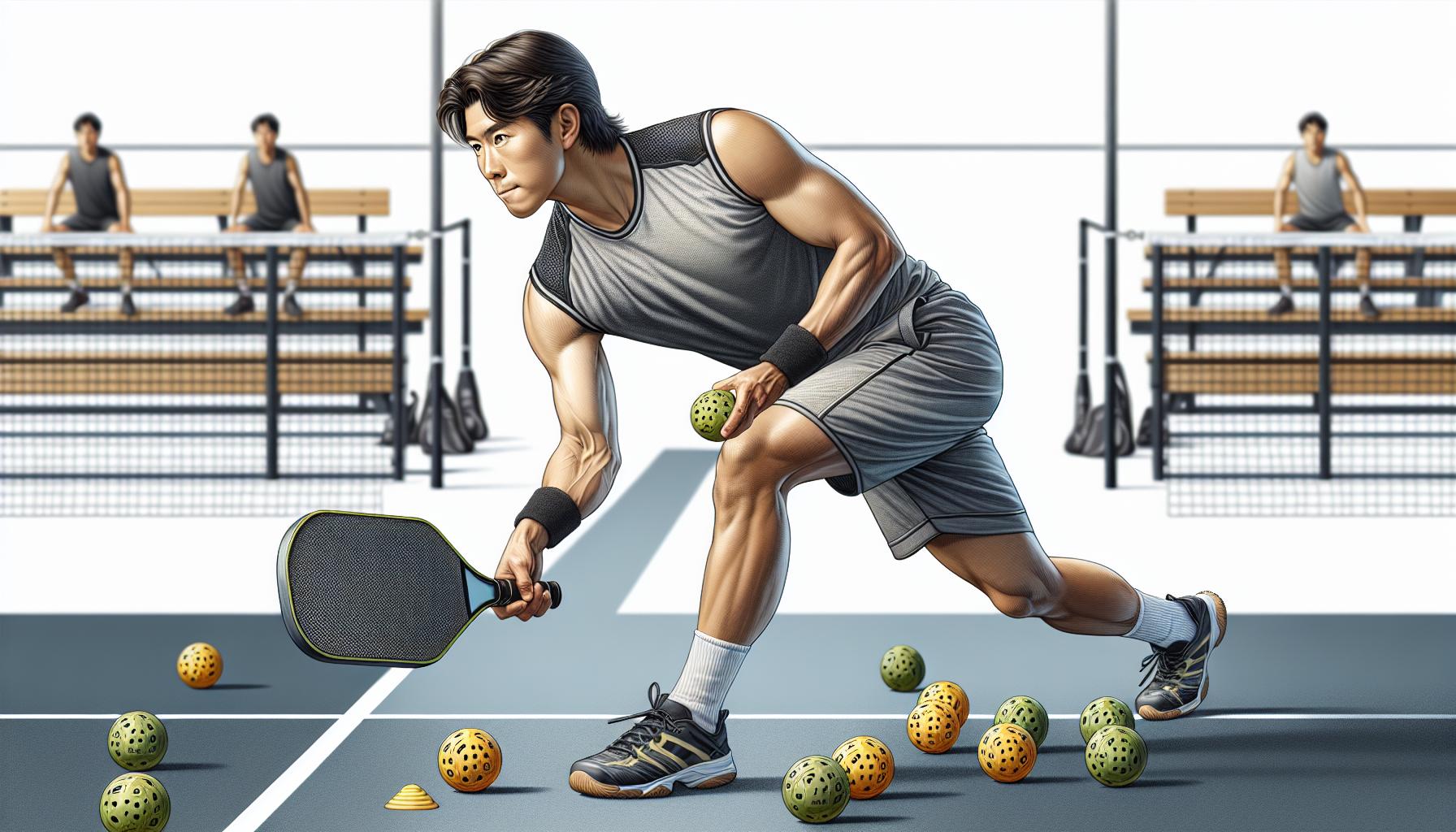
In the world of pickleball, perfecting one’s skills in a solo practice session hinges significantly on the effectiveness of the drills they choose to engage in. Effective drills are the backbone of any fruitful solo practice as they ensure that the player is not merely hitting the ball aimlessly but is working towards concrete improvements in their game.
Firstly, targeted drills ensure that a player can hone specific aspects of their game. Whether it’s improving serve accuracy, enhancing volley shots, or boosting one’s agility on the court, each drill must have a clear objective. This approach ensures that players can methodically address their weaknesses and track their progress over time.
Moreover, drills designed for solo practice are invaluable for building muscle memory. Repetition of the right movements and shots under various scenarios allows players to automate their responses during gameplay. This automaticity is crucial for performing well under pressure when there’s little time to think about technique.
Another aspect of solo drills that can’t be overlooked is their role in mental conditioning. Pickleball, like any sport, is as much a mental game as it is physical. Effective drills challenge players not only physically but also mentally, encouraging them to maintain focus, develop strategies on the fly, and build mental resilience. By simulating game-like conditions, players can prepare themselves for the mental rigors of actual matches.
Effective drills also offer the flexibility of incorporating fitness elements into training sessions. Good physical condition is paramount for excelling in pickleball. Drills that incorporate cardiovascular workouts, agility training, and strength-building exercises ensure that players are not only technically sound but also physically equipped to handle the demands of the game.
Lastly, the adaptability of effective drills to suit various skill levels ensures that players can continue to challenge themselves as they improve. What starts as a basic drill to master forehand shots can evolve into a complex exercise involving footwork, shot placement, and speed. This scalability helps maintain the relevance and challenge of drills, keeping the practice sessions engaging and productive.
By integrating these principles into their solo practice routines, players not only boost their performance on the court but also develop a deeper appreciation for the nuances of pickleball. Through deliberate practice and the right set of drills, players can transform their game, inching closer to their personal best with each session.
Warm-up and Stretching Exercises
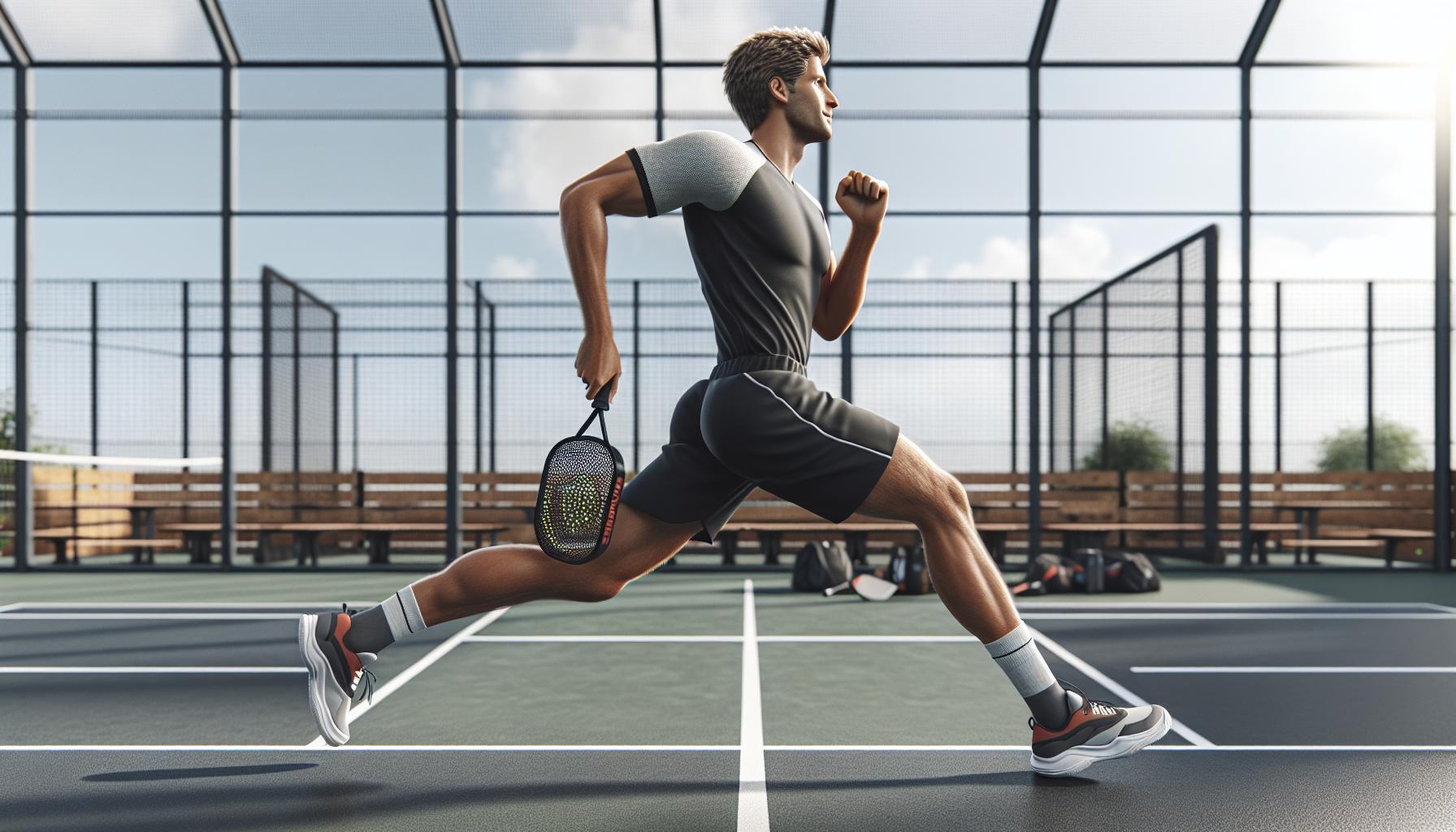
Before diving into the heart of any pickleball drill, warming up and stretching are crucial steps that should never be skipped. They prepare the body for the physical demands of practice, reducing the risk of injury and enhancing overall performance. For pickleball players, focusing on exercises that activate the core, legs, arms, and shoulders is key, as these areas are heavily utilized during the game.
Dynamic Warm-up Activities are the first step in getting the body game-ready. These involve movement-based stretching that mimics the actions of playing pickleball, effectively warming up the muscles and joints. Examples include:
- Jogging or brisk walking around the court for 5 to 10 minutes to get the heart rate up.
- Leg swings to loosen up the hips and legs, making sure to do both front-to-back and side-to-side motions.
- Arm circles and shoulder shrugs to prepare the upper body, increasing in size and intensity gradually.
After the body is warmed up, moving onto more targeted Stretching Exercises helps in increasing flexibility and range of motion, both of which are essential for reaching challenging shots and sustaining quick movements on the court. Recommended stretches include:
- Hamstring Stretch: Placing one foot in front of the other and gently leaning forward while keeping the back straight helps elongate the back of the legs.
- Calf Raises: Rising onto the tiptoes and slowly lowering down works the calf muscles, crucial for quick, explosive movements.
- Forearm Stretch: Extending one arm in front, using the other hand to gently pull back on the fingers, prepares the wrists and forearms for the repetitive motions of serving and volleying.
Integrating Core Strengthening Exercises into the warm-up routine also pays dividends on the court. A strong core is vital for maintaining balance, generating power, and ensuring efficient transfer of energy during gameplay. Simple yet effective exercises include:
- Planks for overall core stability, aiming to hold the position for 30 seconds to a minute.
- Russian twists with or without a weight to engage the obliques, enhancing twisting motions and reach.
- Bridge lifts target the lower back and glutes, areas that support a lot of movement in pickleball.
Drills for Improving Serve Technique
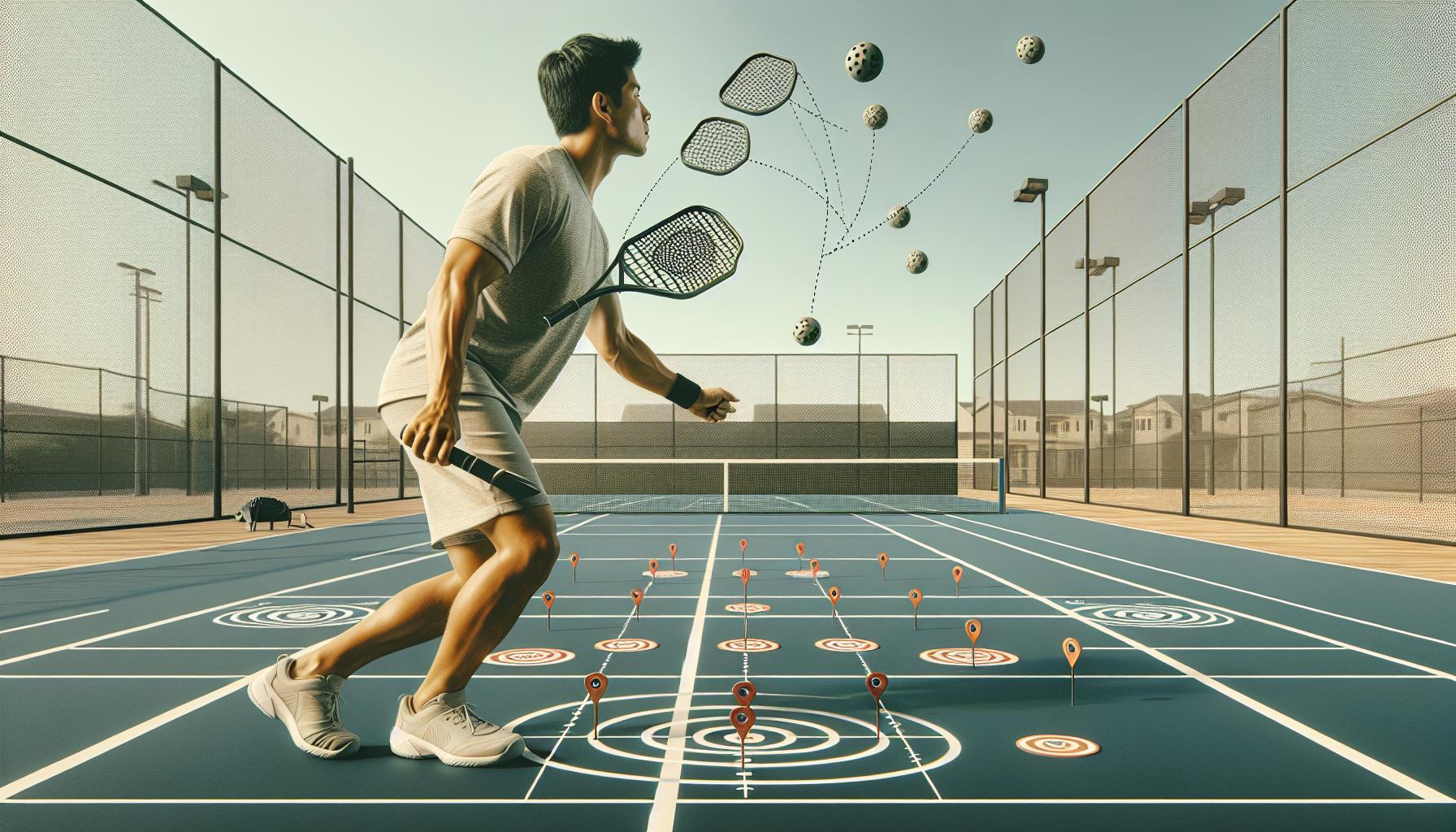
Perfecting one’s serve is a crucial part of advancing in pickleball. A powerful and accurate serve can set the tone for the entire point, putting the opponent on the defensive right from the start. For players looking to hone their serve technique during solo practice, there are a number of drills that can be both effective and engaging.
Target Practice is an excellent way to improve accuracy. Players should place targets at various locations on the court – near the baseline, at the corners, and halfway into the service box. The aim is to hit these targets with the serve. This drill not only enhances precision but also encourages players to vary their serve’s speed and spin to adjust to different distances and angles.
Serve Consistency Drill involves serving a set number of balls, aiming to get as many serves as possible in the service box. Players can start with a goal of 10 serves and gradually increase the count as their consistency improves. This drill is particularly useful for developing a rhythm and increasing confidence in one’s serving abilities.
To focus on Serve Power, tie a resistance band around the waist and anchor it to a fixed point behind the player. Serving while resisting this backward pull helps strengthen the core and arm muscles, leading to a more powerful serve. It’s critical to maintain proper form throughout to maximize the benefits and prevent injury.
For players struggling with their Serve Placement, the Shadow Serve Drill can be invaluable. Without a ball, players go through their serve motion, focusing intensely on the body mechanics and imagining the ball hitting the intended spot. This mental and physical rehearsal helps in developing a more intentional and effective serve.
Incorporating Technology
Modern technology has provided pickleball players with tools to enhance their solo practice even further. High-speed cameras set up at various angles can record serves, allowing players to analyze their body mechanics and ball trajectory in slow motion. Apps and wearable technology can provide instant feedback on serve speed, helping players identify progress and areas that need improvement.
Practice Serve Variations
Mastering different types of serves can give players a competitive edge. Practicing the Spin Serve, where the ball rotates sharply upon hitting the ground, can surprise opponents and force errors. Similarly, working on a Soft Serve that barely crosses the net can disrupt the opponent’s rhythm. Mixing up these variations during practice ensures players are prepared for any match situation.
Drills for Enhancing Footwork
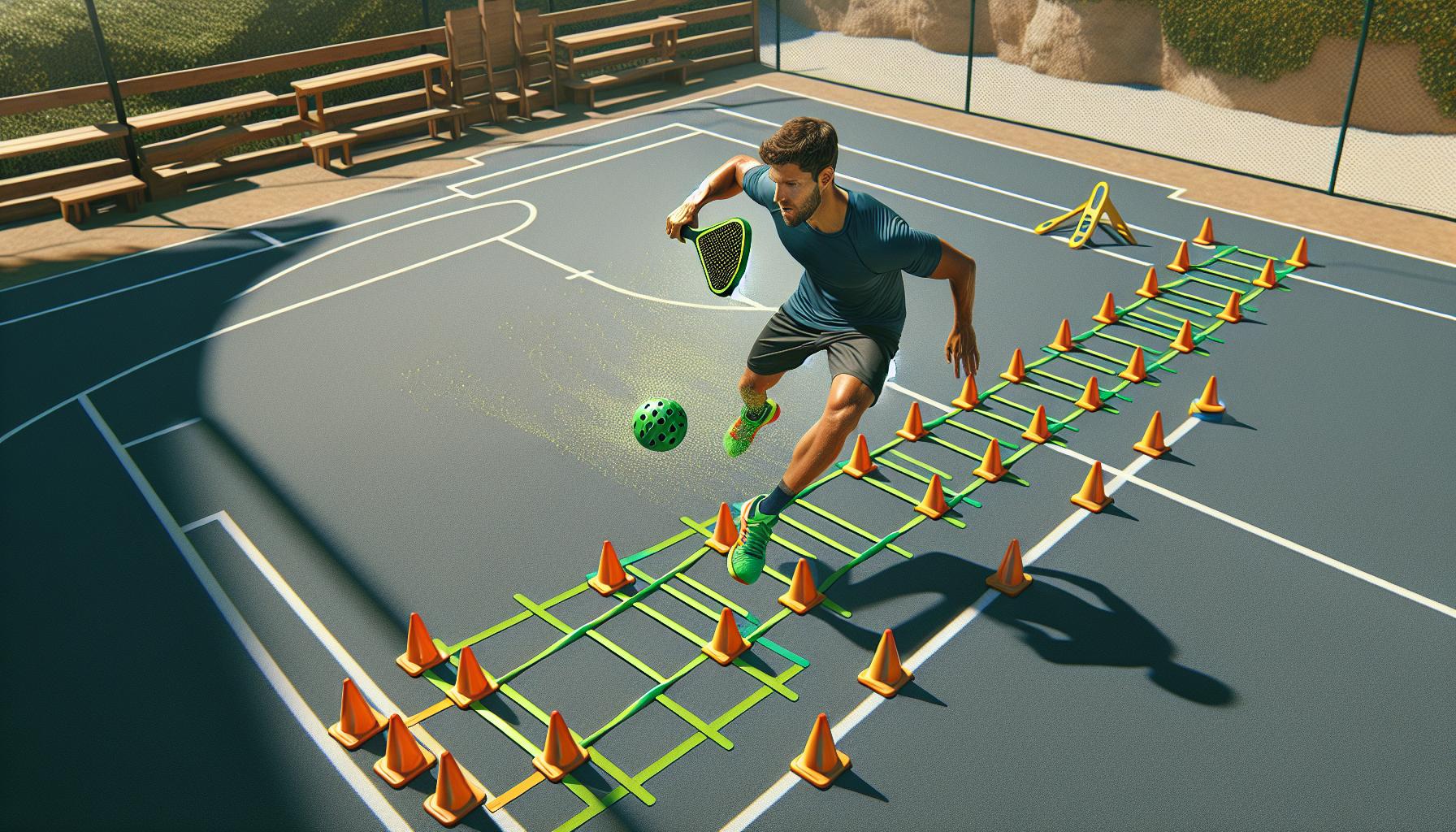
Improving one’s footwork on the pickleball court is crucial for both defensive plays and setting up powerful shots. Since pickleball involves swift changes in direction and speed, players must develop agility and coordination. Solo practitioners can leverage several drills designed to enhance these aspects of their game.
Ladder Drills are highly effective for promoting quick feet movements. They require a player to rapidly move through the squares of a ladder laid on the ground, encouraging high knee lifts and precise foot placements. Different patterns, such as side shuffles, in-and-outs, and zig-zags, not only improve agility but also enhance a player’s ability to change directions swiftly.
Shadowing involves mimicking game movements without a ball. This tactic allows players to focus entirely on their footwork without the distraction of hitting. By visualizing different playing scenarios, athletes can practice moving swiftly across the court to reach imagined shots. It’s a versatile drill that can be tailored to specific areas of improvement, such as reaching wide balls or transitioning quickly from back to front court.
Another vital exercise is the Cone Drills. Setting up cones in various patterns across the court enables players to work on precise footwork and agility. For instance, setting up cones in a straight line and running to touch each one with the paddle before moving to the next hones linear speed. Arranging cones in a zig-zag pattern challenges lateral movement and the ability to pivot effectively.
Incorporating Ball Drops into solo practice can simulate the unpredictability of actual gameplay. Players toss a ball in the air and then quickly move to catch it before it bounces more than once. This drill enhances reaction time and the ability to move swiftly in any direction. It’s beneficial to vary the height and direction of the throws to mimic the variety of shots encountered in a match.
| Drill | Focus Area | Benefits |
|---|---|---|
| Ladder Drills | Agility, Speed | Improves quick feet movement, coordination |
| Shadowing | Movement patterns, Agility | Enhances ability to visualize and react to game situations |
| Cone Drills | Precision, Lateral movement | Promotes accurate footwork, improves agility |
| Ball Drops | Reaction time, Agility | Enhances quick directional changes, boosts reaction time |
Drills for Increasing Accuracy and Control

When it’s about honing in on the precision and control in pickleball, there are a variety of drills players can undertake on their own. Focusing on these elements not only sharpens their aim but also elevates their game strategy. These drills, designed for solo practice, allow athletes to fine-tune their mechanics and achieve a greater level of accuracy and control over the ball.
One fundamental drill is the Wall Rally Drill. This involves hitting the ball against a wall, aiming to keep the rally going for as long as possible. It’s a simple yet effective method for improving hand-eye coordination. To add a layer of challenge, players can mark specific spots on the wall with tape, aiming to hit these targets consistently. The goal is to reach 100 consecutive hits, which significantly improves ball control and the player’s ability to place shots with precision.
Another essential drill for increasing accuracy is the Target Practice Drill. Players can set up targets on the court using cones or similar markers. The aim is to serve or hit groundstrokes towards these targets. This not only enhances serving accuracy but also improves groundstroke placement. Keeping a record of hits and misses can provide valuable feedback and set benchmarks for progress. Variations can include:
- Moving the targets to different locations on the court.
- Switching between forehand and backhand shots.
- Adjusting the distance from which the player hits.
For players looking to refine their control over the ball’s direction and height, the Drop Shot Drill stands out. This involves practicing drop shots from the baseline, attempting to land the ball as close to the net as possible without hitting it. Precision and soft touch are key here, as the goal is to make the ball barely clear the net and drop into the non-volley zone, a skill that can fluster opponents during a match.
By integrating these drills into their routine, pickleball players can greatly enhance their performance. The meticulous focus on accuracy and control not only prepares them for precise shot-making during games but also builds a strong foundation of skills that contribute to overall gameplay improvement. To ensure progress, it’s crucial for players to track their performance over time, adjusting the difficulty of drills as they advance. Whether it’s improving serve placement with Target Practice or mastering the finesse of a drop shot, the journey toward precision and control is both challenging and rewarding.
Drills for Building Stamina and Endurance
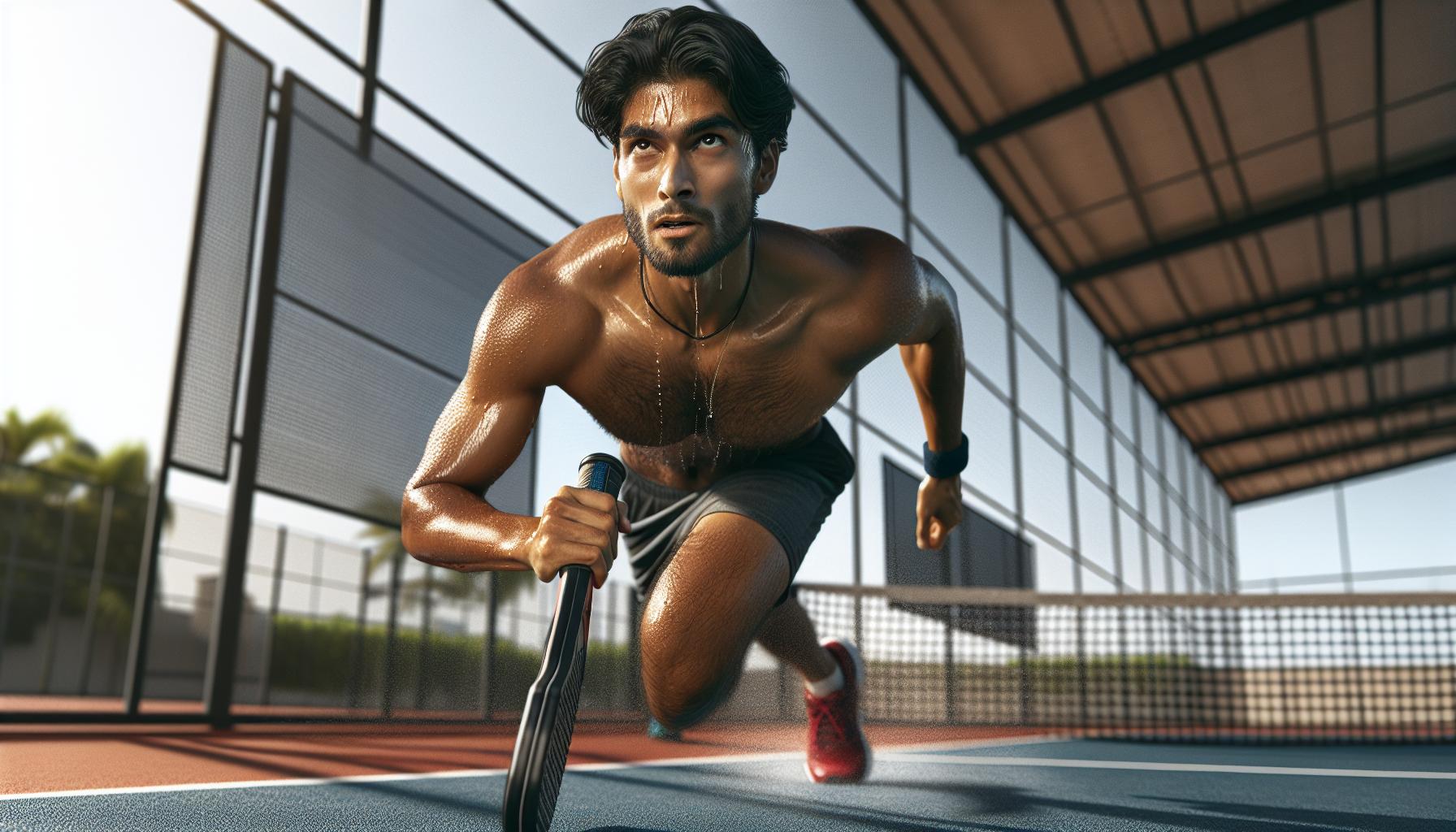
Stamina and endurance play crucial roles in pickleball, allowing players to maintain high performance levels throughout long matches. Incorporating drills that focus on these aspects can significantly boost a player’s staying power on the court. While many drills target technique and precision, stamina-building exercises ensure that players have the physical conditioning necessary to utilize their skills effectively over time.
One effective drill is the Court Sprint Drill. This involves sprinting the length of the pickleball court, touching the baseline, and then jogging back to the starting position. Players should aim to complete this drill in sets of ten sprints, focusing on maintaining a consistent speed throughout each set. This drill not only enhances stamina but also improves speed and agility, making it a multifaceted exercise for serious players.
Another valuable exercise is the Long Rally Drill. Players hit the ball against a wall, aiming to keep the rally going for as long as possible. The goal is to sustain at least a 50-hit rally, with each hit requiring the player to move as they would in a real game. This drill not only builds stamina but also sharpens hand-eye coordination and ball control under fatigue.
For those looking to challenge their endurance further, the Interval Training Drill incorporates bursts of high-intensity activity followed by short recovery periods. Players alternate between intense pickleball drills or sprints and light jogging or walking. A typical session might consist of 1 minute of intense activity followed by 1 minute of rest, repeated for 20 to 30 minutes. Interval training mimics the stop-and-go nature of pickleball, making it an excellent way to build match-ready endurance.
Incorporating Core Strength Exercises into a pickleball stamina routine can also have significant benefits. Exercises like planks, sit-ups, and Russian twists improve core stability, which is vital for maintaining energy and balance during prolonged play. A strong core allows for efficient movement and can help reduce the risk of injury.
Lastly, the Endurance Match Drill simulates the conditions of a real game. Players engage in solo practice or play against a partner, aiming to extend rallies and mimic the movement patterns of a match. The focus is on sustaining a high level of play without sacrificing form or accuracy. Players can set goals such as the number of points or duration of play to push their limits and track improvements over time.
Advanced Solo Drills for Experienced Players
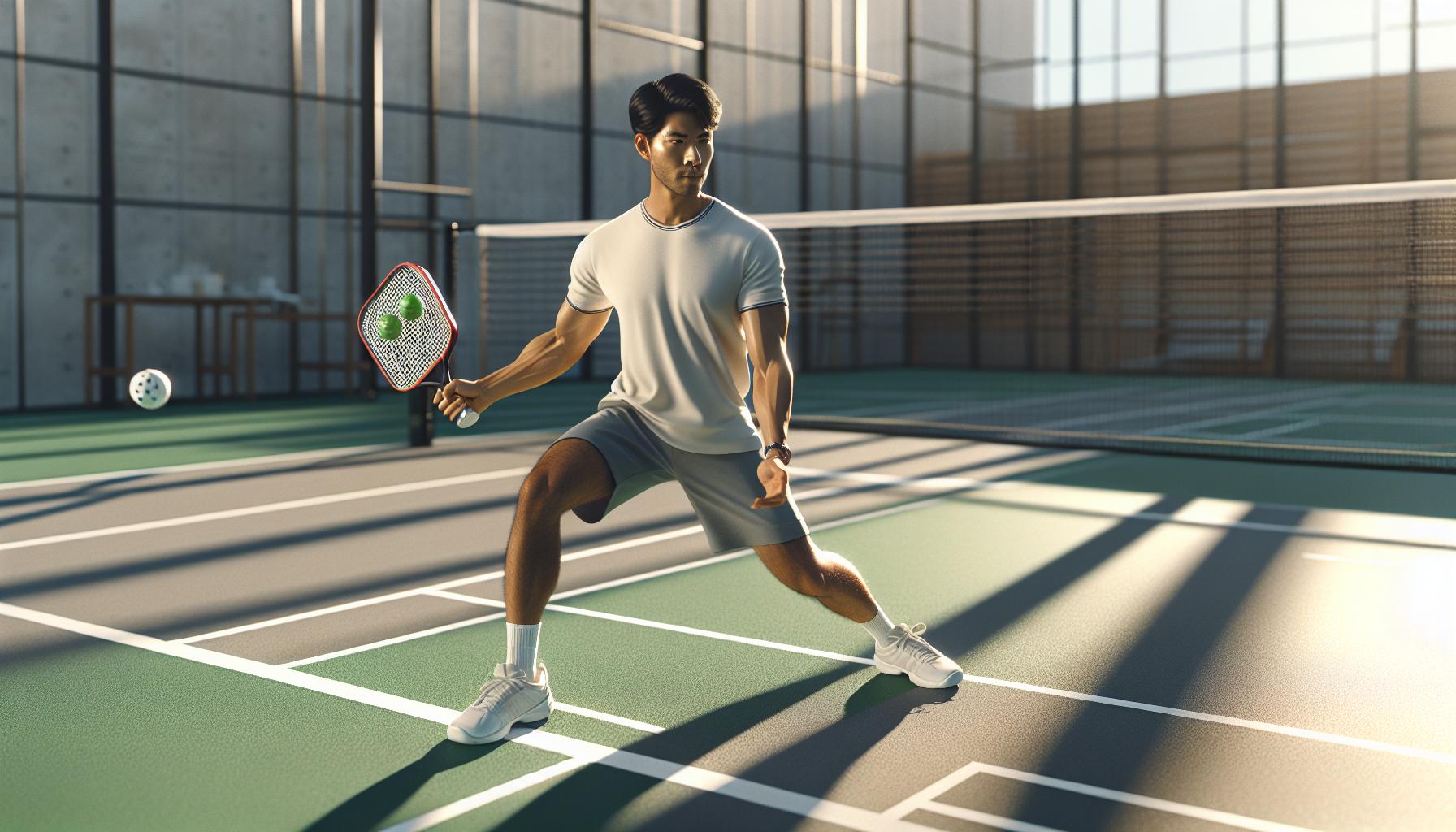
For those pickleball players who’ve honed their basic skills and are looking to challenge themselves further, incorporating advanced solo drills into their routine can be a game-changer. These drills are designed not only to refine and improve existing skills but also to push the boundaries of what players can achieve on the court by themselves.
One standout drill for enhancing precision and agility is the Cross-Court Dink Drill. Players can use either a ball machine or a rebound net to practice this drill. They should aim to hit the ball diagonally across the court, targeting the kitchen area with soft, controlled dinks. By setting a goal of consecutive successful shots, players can challenge their consistency and precision under pressure.
Another effective drill for experienced players is the Serve and Sprint Drill. This exercise combines serving accuracy with speed and agility. After serving, players immediately sprint towards the net, preparing for a phantom volley, then quickly backpedal to the baseline to receive an imaginary return. This drill simulates real-game movement and helps improve serve accuracy, court speed, and transition movements between shots.
For those looking to improve their power and depth control, the Baseline Power Drill is highly recommended. Players aim to consistently hit deep shots from the baseline into the opposing court’s back third. Using targets can help with accuracy, while focusing on hitting with power ensures the ball travels quickly, simulating the pace of a real match.
Integrating these drills into a solo practice session requires not just physical endurance but also mental focus. Experienced players understand the importance of visualization in their practice. Imagining an opponent’s movements and responses can help translate the skills developed in solo drills to actual match scenarios. This mental aspect of solo practice shouldn’t be underestimated, as it significantly contributes to a player’s ability to anticipate and react during competitive play.
Advanced drills not only challenge players physically but they also provide valuable feedback for areas of improvement. Regularly incorporating these exercises into solo practice sessions ensures that experienced players continue to develop their skills, staying ahead in their game.
By focusing on precision, agility, power, and mental acuity, these advanced solo drills offer a comprehensive approach to improving all facets of a player’s pickleball game. Whether it’s mastering the art of the dink, enhancing serve accuracy, or building power behind baseline shots, there’s always room for growth and perfection.
Conclusion
Embracing these drills during solo practice sessions is a game-changer for pickleball enthusiasts. Starting with a solid warm-up and stretching routine sets the stage for a successful practice by keeping injuries at bay and ensuring the body is primed for action. The drills outlined, from basic techniques to advanced strategies, offer a comprehensive approach to improving every aspect of the game. Whether it’s enhancing serve technique, footwork, or mastering the art of precision and power through advanced drills, there’s something for players at every level. By dedicating time to these exercises, players will not only see noticeable improvements in their game but also enjoy the journey of becoming more skilled and confident on the court. So grab your paddle, hit the court, and let the journey to pickleball mastery begin!

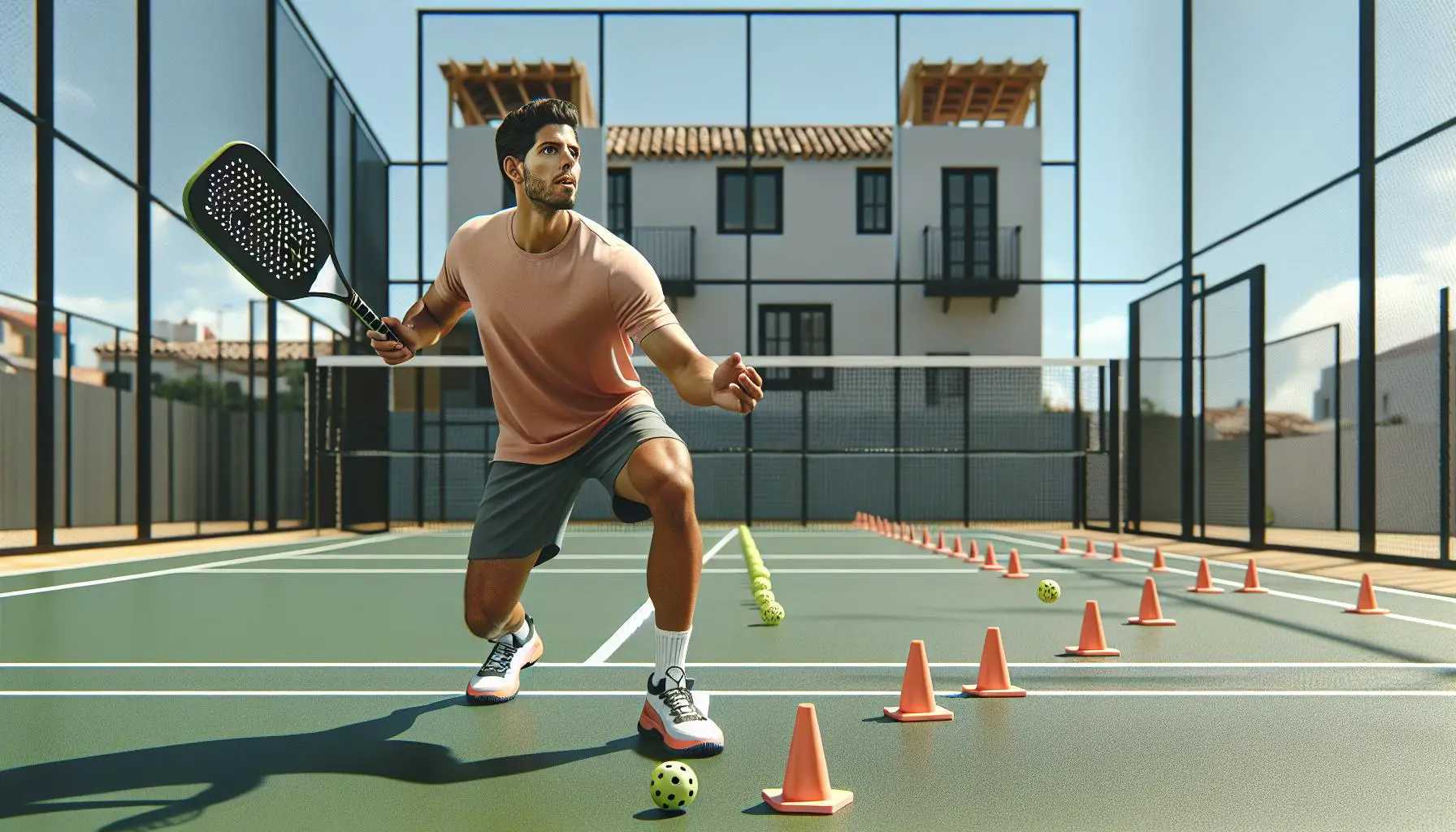









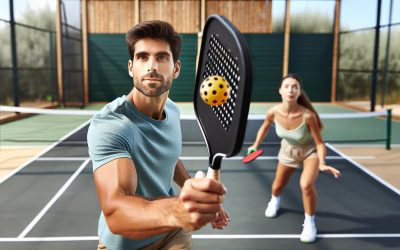
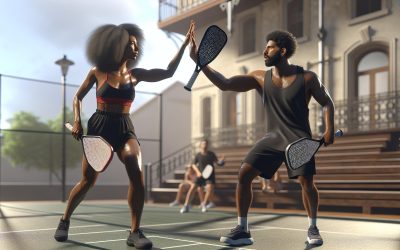
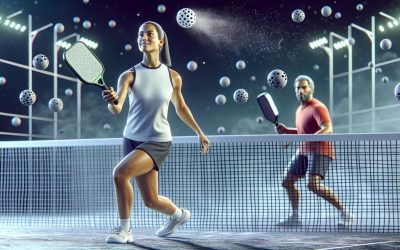
0 Comments